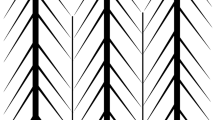Summary
The sacrotuberous ligament of man is not the transformed caudal head of one of the hamstring muscles as is supposed by most authors. It is derived from the posterior part of the aponeurosis of the superficial gluteal muscle, and has originated by translocation of the caudal head of this muscle from the tail to the ischial tuberosity in a pongid-like stage of our evolution.
Zusammenfassung
Vergleichend-myologische Beobachtungen an der Hüftregion liefern keinen Anhalt für die verbreitete Vorstellung, wonach das Lig. sacrotuberale aus dem Schwanzkopf eines ischiocruralen Muskels hervorgegangen sein soll. Bei rezenten Primaten liegen Verhältnisse vor, die uns modellhaft vor Augen führen, wie sich dieses Band aus der Aponeurose des Schwanzteiles des M. glutaeus superficialis in einem menschenaffenähnlichen Stadium unserer Phylogenese entwickelt hat.
Similar content being viewed by others
Literatur
Appleton, A. B.: The phylogeny of the sacrotuberous ligament and of certain mammalian thigh muscles. J. Anat. (Lond.) 61, 511 (1926).
—: The muscles and nerves of the post-axial region of the tetrapod thigh. J. Anat. (Lond.) 62, 364–438 (1928).
Bardeen, C. R.: Development and varation of the nerves and the musculature of the inferior extremity and the neighboring regions of the trunk in man. Amer. J. Anat. 6, 259–390 (1907).
Bluntschli, H.: Die Fascia lata und ihre Bedeutung für die Umbildung des Gefäßapparates an der unteren Gliedmaße in der Primatenreihe. Verh. anat. Ges. 1913. Anat. Anz. 44 (Suppl.), 43–66 (1913).
Broek, A. J. P. van den: Studien zur Morphologie des Primatenbeckens. Morph. Jb. 49, 1–118 (1915).
Fick, R.: Handbuch der Anatomie und Mechanik der Gelenke, Teil 1: Anatomie der Gelenke, in v. Bardelebens Handbuch der Anatomie der Menschen. Jena: Fischer 1904.
Fiedler, W.: Übersicht über das System der Primaten. In: Hofer, Schultz und Starck: Primatologia, vol. 1, p. 1–267. Basel-New York: Karger 1956.
Gerhartz, M.: Vergleichend-anatomische und vergleichend-funktionelle Untersuchungen an der Hüft- und Oberschenkelmuskulatur des amerikanischen Greifschwanzaffen Ateles; med. Diss. Düsseldorf (1962).
Keith, A.: The ligaments of pelvis of the catarrhine monkeys with references to corresponding structure in man. J. Anat. Physiol. (Lond.) 28, 149–168 (1894).
Keith, A.: Myology of the Catarrhini. A study in evolution; M. D. thesis London (1919).
Klaatsch, H.: Der kurze Kopf des M. biceps femoris und der M. tenuissimus. Ein stammesgeschichtliches Problem. Morph. Jb. 29, 217–281 (1902).
Kleinschmidt, A.: Funktionell-morphologische Beobachtungen am Becken der Säuger unter besonderer Berücksichtigung der Primaten. Verh. dtsch. Zoologen Kiel 1948. Zool. Anz. 13 (Suppl.) 95–103 (1949).
Kolesnikow, W. W.: Zur vergleichenden Anatomie des M. glutaeobiceps bei Säugetieren. Z. Anat. Entwickl.-Gesch. 99, 538–570 (1933).
Robinson, A. (ed.): Cunningham's Text-book of anatomy, 5th ed. London: Frowde and Hodder & Stoughton 1922.
Schumacher, O., Lebzelter, V.: Zur Kenntnis der Oberschenkelmuskulatur von Mormon sphinx, Z. Anat. Entwickl.-Gesch. 71, 282–303 (1924).
Testut, L., Latarjet, A.: Traité d'anatomie humaine, 9e ed. Paris: Doin & Cie. 1948.
Uhlmann, K.: Hüft- und Oberschenkelmuskulatur. Systematische und vergleichende Anatomie. In: Hofer, Schultz und Starck, Primatologia, vol. 4, Lieferung 10. Basel-New York: Karger 1968.
—: Die phylogenetische Entwicklung der Hüft- und Oberschenkelmuskulatur der Primaten. Folia primatol. 15, 88–116 (1971).
—: Zur Hømologie der oberflächlichen Gesäßmuskulatur des Orang-Utan. Z. Morph. Tiere 71, 180–188 (1972).
Ziegler, H.: Die Innervationsverhältnisse der Beckenmuskeln bei Haustieren im Vergleich mit denjenigen des Menschen. Sind die Mm. glutaeus superf., biceps fem., semitendinosus und-membranosus unserer Haussäugetiere (Pferd, Rind, Ziege, Schaf, Schwein, Hund und Katze) denjenigen des Menschen homolog? Morph. Jb. 68, 1–45 (1931).
Zielińska, H.: Antropomorfologja m. glutaei maximi. Folia morph. (Warszawa) 7, 84–113 (1936/37).
Author information
Authors and Affiliations
Rights and permissions
About this article
Cite this article
Uhlmann, K. Die phylogenetische Herkunft des Ligamentum sacrotuberale des Menschen. Z. Anat. Entwickl. Gesch. 136, 1–8 (1972). https://doi.org/10.1007/BF00521098
Received:
Issue Date:
DOI: https://doi.org/10.1007/BF00521098




